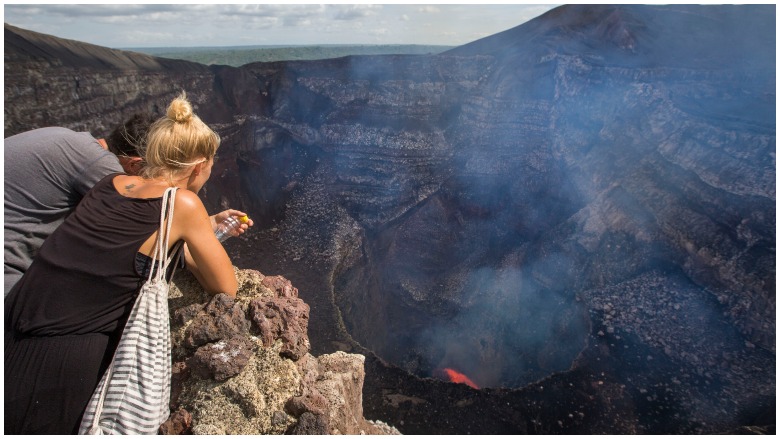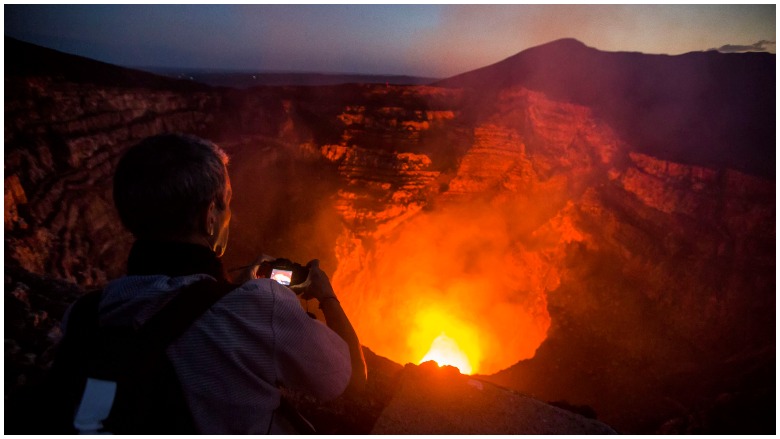
Getty Masaya volcano
Highwire performer Nik Wallenda completed the most daring walk of his career on March 4, 2020, when he crossed 1,800 feet over the mouth of the Masaya volcano during a live broadcast special on ABC. The volcano erupted in 2008 but blew ash out of its top as recently as October 2019.
Masaya, located in Nicaragua, is one of the most active volcanoes in the world and even has the nickname “the mouth of hell.” It currently has an active lava lake churning in its crater that reaches temperatures of 2,000 degrees.
Wallenda prepared for the extreme elements. He wore goggles and a mask to protect himself from the toxic fumes. The cable and his shoes were thicker than normal due to the excessive heat. But as Wallenda himself has discussed, he could not prepare in the case of volcanic activity.
The last time lava flowed out of Masaya was 1772. But the volcano has erupted at least 13 times in the past 30 years. Scientists also say it’s possible a major explosion could occur without much warning, according to recent findings based on satellite imagery.
Here’s what you need to know.
The Masaya Volcano Last Erupted Ash In October 2019

GettyMasaya volcano
Nik Wallenda may not have needed to worry about an apocalyptic explosion that viewers would see in a movie. But the Masaya volcano is known to shoot ash into the air that travels miles away. The most recent time Masaya did this was October 2019.
According to the USGS Weekly Volcanic Activity Report from the Smithsonian Institute, Masaya erupted ash on October 15, 2019. The event caused “very minor ashfall” in communities located nearly four miles away.
Scientists also detected a small explosion in July 2019. It originated from the floor of the Santiago crater, which contains the lava lake. The volcano “produced a gas-and-ash plume” that sprinkled surrounding communities with ash.
2008 was an active year for volcanic activity. In April of that year, Masaya erupted ash out of its top that reached a height of more than a mile. Subsequent emissions were recorded in September, November and December.
The eruption that occurred in April 2001 caused injuries. Masaya launched rocks the size of footballs about a quarter-mile away and damaged vehicles, the Herald-Tribune reported. Tourists were close to the top when Masaya blew and several people were hurt.
Scientists Say Masaya Could Erupt Without Warning Because Its Magma Supply Is Centered Nearly Two Miles Away From the Crater
Researchers from Penn State University recently used satellite technology to take a closer look at the areas surrounding Masaya. They discovered that Masaya is supplied by a reservoir of magma that is located nearly two miles away from the crater. The findings were published in March 2018.
This was a major revelation because it could change how scientists monitor volcanic activity. As the team explained in a news release, one method to determine whether a volcano is about to erupt is to analyze ground swelling. This indicates a buildup in magma supply underground. Sensors on the ground help to monitor this activity.
But at Masaya, Penn State researchers figured out the ground was swelling north of the crater. Doctoral student Kirsten Stephens explained that their satellite technology helped to spot clues that ground sensors likely would have missed.
Penn State assistant professor of geosciences Christelle Wauthier, who led the team analyzing Masaya, explained the magnitude of their discovery. “This shows that you should monitor close to the active vent area but also farther away to get a broader picture of the magma processes. This is clear evidence showing magma can be supplied in large quantities further away from the point of eruption.”
READ NEXT: What Happens If Nik Wallenda Falls?
Comments
Masaya Volcano Activity: When Was Its Last Eruption?